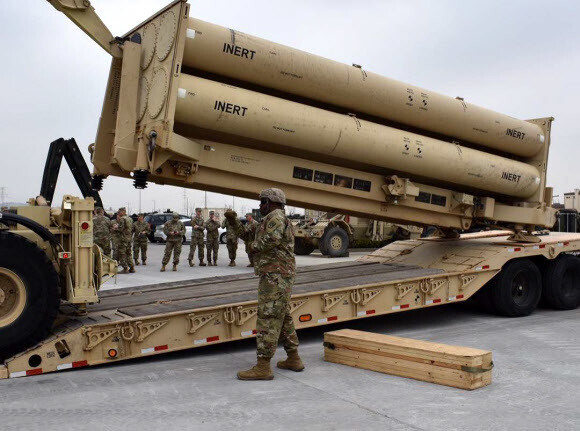hankyoreh
Links to other country sites 다른 나라 사이트 링크
[Editorial] US’ THAAD plans should not further compromise S. Korea-China relations

The US’ plan to allocate considerable funds to upgrade the capabilities of the THAAD missile defense system, deployed in Seongju, North Gyeongsang Province, was revealed in a draft budget for the 2021 fiscal year, published by the US’ Missile Defense Agency on Feb. 14. Reports show that the US has already explained this plan to the South Korean government. This plan contains the options of deploying more THAAD launchers to Seongju and forward-deploying the launchers to the greater Seoul area. There are also indications that the US is working on integrating the THAAD and Patriot missile defense networks.
Although South Korea’s Ministry of National Defense said that it hasn’t discussed the deployment of more launchers or the forward deployment of the system with the US, we can’t help worrying about such US actions given the serious conflict between South Korea and China that was triggered by the initial THAAD deployment.
The plan released by the Pentagon wouldn’t increase the size of the THAAD unit in Seongju. But adding another launcher or forward-deploying the unit to the greater Seoul area could be enough to incite pushback from South Korea’s neighbors. Furthermore, upgrading THAAD to link it with the Patriot network makes it more likely that the THAAD radar in Seongju would not only serve the Korean Peninsula but also be incorporated into the US missile defense network. That would inevitably have a major impact on the security terrain on the Korean Peninsula and provoke a harsh response from China, Russia, and North Korea.
When South Korea-China relations deteriorated following the initial THAAD deployment, the South Korean government was barely able to repair them in 2017 by declaring the “three no’s” — namely, promising not to participate in a US missile defense system, not to deploy any more THAAD units, and not to join a trilateral military alliance with the US and Japan. But there’s no doubt that those “three no’s” would be seriously undermined if the THAAD and Patriot systems are integrated and hooked up to the US’ missile defense system, as the US plans.
After the surprise decision to deploy THAAD in South Korea in 2016, the South Korean economy was harmed considerably by China’s ban on South Korean cultural exports, the suspension of group tours to the country, and a steep decline in exports; the impact of those moves is still felt today. The South Korean government needs to make absolutely clear that the US’ plan to upgrade THAAD won’t weaken the “three no’s.”
Rumors of US planning to demand that Seoul pay for additional THAAD constructionFurthermore, reports indicate that the US is considering the option of allocating 58 billion won (US$49.13 million) for construction at the THAAD site in Seongju in next year’s defense budget and then drawing that money from South Korea’s financial contribution to defense cost-sharing.
The South Korean Ministry of National Defense has explained that the US is paying the cost of deploying THAAD and that South Korea is providing the land and basic infrastructure. In response, the government needs to lay down hard-and-fast principles to ensure the US doesn’t use this as leverage in the ongoing cost-sharing negotiations.
Please direct comments or questions to [english@hani.co.kr]

Editorial・opinion
![[Column] Season 2 of special prosecutor probe may be coming to Korea soon [Column] Season 2 of special prosecutor probe may be coming to Korea soon](https://flexible.img.hani.co.kr/flexible/normal/500/300/imgdb/original/2024/0426/3317141030699447.jpg) [Column] Season 2 of special prosecutor probe may be coming to Korea soon
[Column] Season 2 of special prosecutor probe may be coming to Korea soon![[Column] Park Geun-hye déjà vu in Yoon Suk-yeol [Column] Park Geun-hye déjà vu in Yoon Suk-yeol](https://flexible.img.hani.co.kr/flexible/normal/500/300/imgdb/original/2024/0424/651713945113788.jpg) [Column] Park Geun-hye déjà vu in Yoon Suk-yeol
[Column] Park Geun-hye déjà vu in Yoon Suk-yeol- [Editorial] New weight of N. Korea’s nuclear threats makes dialogue all the more urgent
- [Guest essay] The real reason Korea’s new right wants to dub Rhee a founding father
- [Column] ‘Choson’: Is it time we start referring to N. Korea in its own terms?
- [Editorial] Japan’s rewriting of history with Korea has gone too far
- [Column] The president’s questionable capacity for dialogue
- [Column] Are chaebol firms just pizza pies for families to divvy up as they please?
- [Column] Has Korea, too, crossed the Rubicon on China?
- [Correspondent’s column] In Japan’s alliance with US, echoes of its past alliances with UK
Most viewed articles
- 1Is Japan about to snatch control of Line messenger from Korea’s Naver?
- 2‘We must say no’: Seoul defense chief on Korean, USFK involvement in hypothetical Taiwan crisis
- 3[Editorial] Korea’s surprise Q1 growth requires objective assessment, not blind fanfare
- 4Division commander ordered troops to enter raging flood waters before Marine died, survivor says
- 5The dream K-drama boyfriend stealing hearts and screens in Japan
- 6S. Korea “monitoring developments” after report of secret Chinese police station in Seoul
- 7[Column] Season 2 of special prosecutor probe may be coming to Korea soon
- 8No good, very bad game for Korea puts it out of Olympics for first time since 1988
- 9[Column] ‘Choson’: Is it time we start referring to N. Korea in its own terms?
- 10Is N. Korea threatening to test nukes in response to possible new US-led sanctions body?